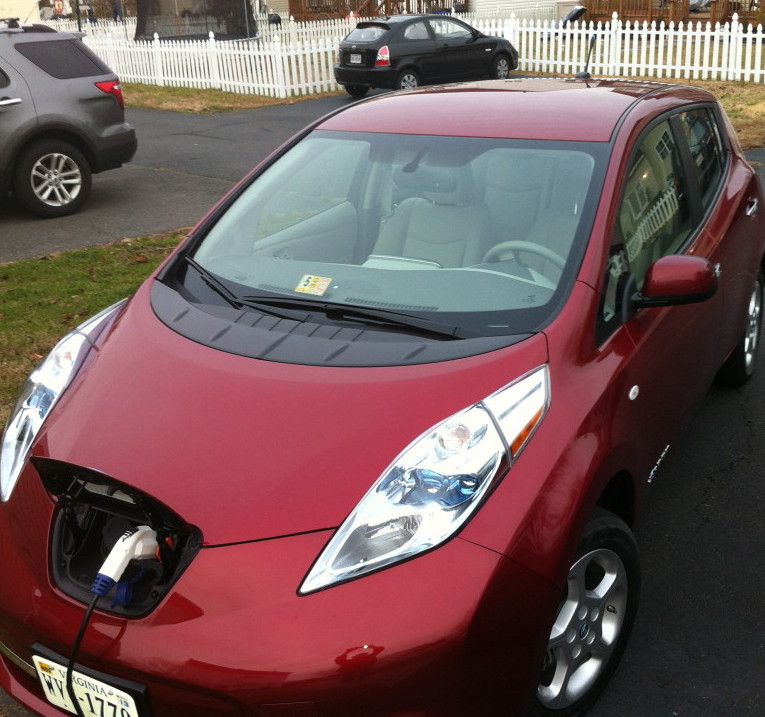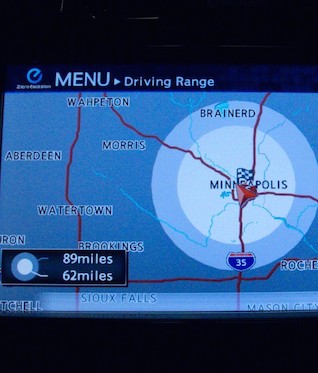 I tend to get a lot of playful (and in some instances, not-so-playful) ribbing about investing in an electric car.  Potshots range from my overreaction to the state of planetary resources to my tree-hugging, liberal opinions. The joke of the night at my last family gathering was “The problem with Tee’s new car is the plug doesn’t reach all the way from D.C. to Richmond.â€
I tend to get a lot of playful (and in some instances, not-so-playful) ribbing about investing in an electric car.  Potshots range from my overreaction to the state of planetary resources to my tree-hugging, liberal opinions. The joke of the night at my last family gathering was “The problem with Tee’s new car is the plug doesn’t reach all the way from D.C. to Richmond.â€
That’s my brother. He’ll be here all week. Don’t forget to tip the wait staff. Try the veal.
My sister-in-law and teenage nephew, however, were asking legitimate questions about the range of the LEAF, how running other systems like climate control or the entertainment system affected the drive, and what I needed to recharge an electric car. These were questions that I really hadn’t considered when deciding to drive green. It wasn’t until I read this article about misconceptions around electric cars that I started to pay closer attention to what people were asking me, and started to notice the same questions and statements coming up, all centered around similar assumptions.
- You can’t get very far in an electric car, can you? The range of an EV varies from make and model, and as for my own choice the LEAF can make a round trip of 100 miles (or 160 km) on a full charge. That may not sound very far but the 2009 National Household Travel Survey study from the U.S. Department of Transportation concluded that 63% of daily vehicle trips are between one and nine miles (two and fourteen kilometers) in length. Furthermore the NHTS found that 16% of all daily vehicle trips fell between between 10-19 miles (16-30 km) in length, 9% are between 20-49 miles (32-79 km), and long-distance travel (trips of 50 miles or greater) fall within 3% of all trips. Even for the 3% who are traveling long distances, EVs can still manage as a feasible alternative provided charging stations are available.
-
There are not enough charging stations available to support EVs, are there?
This depends on where you live, but for myself I live in Manassas, Virginia. I’m roughly 30 miles (48 km) outside of Washington, D.C. In what many regard as “the boonies†of the D.C. Metro area, there are eight charging stations, three of them in Historical Old Town Manassas. Charles Town, West Virginia, (within range of my LEAF) sports 14 Level 2 charging stations at a single, solar-powered bay, completely free to the public. While your options will vary depending on what area of the country, there are mobile apps and websites like CarStations and ChargePoint that will help you find the charging station closest to you.
-
 You need a charging station built into your house and that is expensive.
You need a charging station built into your house and that is expensive.Yes, it is expensive to have a personal charging station built in to your house.
No, you do not need a charging station. The dealership where you lease or purchase the car from will give you the necessary equipment needed to recharge your batteries, and this equipment connects to any exterior plug outlet. If your driveway is not close to an outlet, then you may have to get an extension cord.
-
It takes over 20 hours to charge up an EV battery. That is correct. It takes approximately 21 hours to charger a battery from a low charge (1-5 miles remaining) to 100% charge with a Level 1 (120v) Charger. This is commonly known as a Trickle Charge.
On a Level 2 (240v) Charger, the recharge drops to 4-8 hours of charging time, or adding 10-20 miles to the EV’s battery for each hour of charging. While home charging stations are Level 1, most public stations are Level 2. With the ChargePoint network, you can find Level 2 charging stations with a simple search.
Level 3  “Fast Charge†stations (a growing network, thanks to Tesla Motors) can charge up low batteries within twenty minutes. They are now available at Dulles International Airport and some shopping centers, one located in Centreville, VA. (A downside of the Chevrolet Volt is you are limited to Level 1 and Level 2 charges only. Level 3 is currently not an option.)
-
If you really want to go long distances, you can’t run anything in the car like the air conditioning, the stereo, or – if it’s winter – the seat warmers, right? If you do run the climate control, that can easily tax your battery for 20-30 miles of distance. However, in the case of the LEAF SL which I’m driving, there is a solar panel array in the spoiler that charges an auxiliary battery dedicated for the car computer systems and accessories like the audio system, supplemental restraint systems, headlights and windshield wipers. Another option is range-extenders which is the Chevy Volt. The Volt has a small 9-gallon petrol tank that provides assistance to the battery once the initial charge is done. The Volt is still an EV, but switches from zero emission to low emission when running on the gas tank. So while not as extreme a change as the purely electric LEAF, the Volt can get you beyond the range of the battery.
I saved the best one for last…
-
EV drivers are douchebag assholes that drive like shit and act holier than thou, not because of ecology, climate change, or anything altruistic. If EV drivers truly want to cut down on environmental issues, they would move to a city, use public transport, or ride a bike.Â
 No kidding. I got this just the other night on Facebook.
No kidding. I got this just the other night on Facebook.So, I bring up this brushing with a broad brush because this is when politics and propaganda creep into this odd smear campaign against electric vehicles. For myself, I had two terrific ICE cars (Internal Combustion Engine automobiles, average mileage of 33-35 mpg each); and when I found myself in need of a new car, I wanted to explore better options. I had already tried out a hybrid which was a real delight, but I wanted to find out more about EVs after a Plug-In Day in downtown Manassas. I test drove both the Volt and the LEAF; and while the Volt was a wonderful drive, the LEAF lease was too good to pass up. Sure, I could have taken public transport to work, and in the process doubling my commute time. The LEAF was a perfect option then; and to this date, it is still a perfect commuter car for getting around town. The second biggest fault of this myth, though, is that if commuting is your issue then just move because selling a house and uprooting your family is a much more considerate and rational option than being an EV-driving douchebag.
Hmm…okay…
Side stepping  common sense, there are businesses where public transit is not a viable option. Sure, if your office is in a city, it’s not a problem; but I have contracted with clients who are in no way connected to a bus or train line. So should I take a cab? Yeah, that’s a reliable and economic solution. (See earlier snark on Common Sense.) There are some occupations that demand an automobile, so why not consider an EV? Admittedly, if you buy an EV without test driving, yes, that is foolish. You may find the drive isn’t to your liking. (I felt that way when I test drove the MiEV. Not really a comfortable ride for me.)
Perhaps the weakest part of this myth is this instant transformation into “self-absorbed prick” once you buckle into an EV. It’s as if the Liberal Fairy—that mythical creature who, ironically, is that same mythical creature that sways your political views through Facebook memes—touches you with its (eco-friendly) magic wand and turns you into a right plonker. This kind of stereotyping reminds me a lot of the negative press Apple Computers struggled against in the late nineties and early 2000’s, and even to this day. I have met a lot of neat people through my EV networks, all of them investing in EVs for a variety of reasons, ranging from support for American car manufacturers to improving the environment to working along the bleeding edge of technology. If I would describe the EV community in a word, it is approachable. Both Pip and I have been approached by people noticing our EVs and asking us questions like “How do they handle?” and “Are they really worth the investment?”
I can assure you that if you are the president of your Band Boosters, a priest, or an animal rescue crusader, you do not suddenly become a jerk once you test drive an EV. If you are that commuter—one who cruises in a passing lane, double-parks in order to make sure their baby is protected, switches lanes without signaling, for example—after purchasing an EV, there’s a strong possibility you were already that commuter back when you were driving your SUV, F-250, or tricked-out Celica.Â
Some of this mythbusting you will do when researching your EV of choice. Some of these discoveries you make while learning your way around the vehicle. What will continue to surprise you is the bad press and sometimes wild conjectures people make about the EVs. It is understandable though as the EV is still a new technology. This is the bleeding edge of technology, folks, and there is a lot to learn. Whether it is with your local dealership or this column, questions are always a good thing. Ask many. Ask often.
And when you find an EV driver, ask away. Speaking from experience, we love to talk about life in the green lane.
Tee is not only blogging about his experiences with the EV lifestyle, he has established a Twitter account for the LEAF. You can follow EV news and the travels of Joan at @EV_Joan on Twitter.
